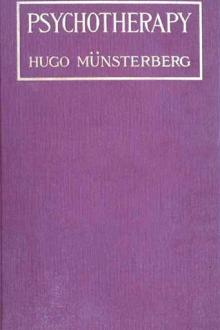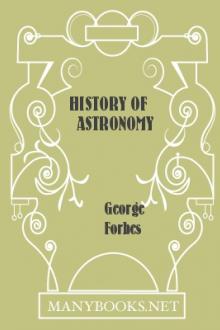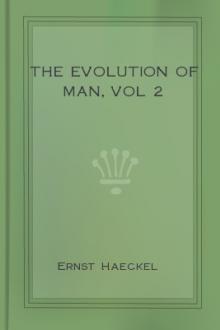Sixteen Experimental Investigations from the Harvard Psychological Laboratory by Hugo Münsterberg (100 books to read .txt) 📕

- Author: Hugo Münsterberg
- Performer: -
Book online «Sixteen Experimental Investigations from the Harvard Psychological Laboratory by Hugo Münsterberg (100 books to read .txt) 📕». Author Hugo Münsterberg
second, that there is, in fact, no such thing as fusion, is a
supposition which is in such striking contrast to all previous
explanations of optical phenomena, that it should be accepted only if
no other theory can do justice to them. It is hoped that the following
pages will show that the facts do not demand such a theory.
Another simple observation is interesting in this connection. If at
any time, except when the eyes are quite fresh, one closes one’s eyes
and attends to the after-images, some will be found which are so faint
as to be just barely distinguishable from the idioretinal light. If
the attention is then fixed on one such after-image, and the eyes are
moved, the image will suddenly disappear and slowly emerge again after
the eyes have come to rest. This disappearance during eye-movements
can be observed also on after-images of considerable intensity; these,
however, flash back instantly into view, so that the observation is
somewhat more difficult. Exner,[2] in speaking of this phenomenon,
adds that in general “subjective visual phenomena whose origin lies in
the retina, as for instance after-images, Purkinje’s vessel-figure,
or the phenomena of circulation under discussion, are almost
exclusively to be seen when the eye is rigidly fixed on a certain
spot: as soon as a movement of the eye is made, the subjective
phenomena disappear.”
[2] Exner, Sigmund, _Zeitschrift f. Psychologie u. Physiologie
der Sinnesorgane_, 1890, I., S. 46.
The facts here mentioned in no wise contradict a phenomenon recently
discussed by McDougall,[3] wherein eye-movements revive sensations
which had already faded. Thus an eye-movement will bring back an
after-image which was no longer visible. This return to vividness
takes place after the movement has been completed, and there is no
contention that the image is seen just during the movement.
[3] McDougall, W., Mind, N.S., X., 1901, p. 52.
The disappearance of after-images during eye-movements is mentioned by
Fick and Gürber,[4] who seek to explain the phenomenon by ascribing it
to a momentary period of recovery which the retina perhaps undergoes,
and which would for the moment prevent further stimulations from being
transmitted to the optic nerve. Exner observes that this explanation
would not, however, apply to the disappearance of the vessel-figure,
the circulation phenomenon, the foveal figure, the polarization-sheaf
of Haidinger, Maxwell’s spot, or the ring of Löwe; for these phenomena
disappear in a similar manner during movement. Exner offers another
and a highly suggestive explanation. He says of the phenomenon (_op.
citat._, S. 47), “This is obviously related to the following fact,
that objective and subjective impressions are not to be distinguished
as such, so long as the eye is at rest, but that they are immediately
distinguished if an eye-movement is executed; for then the subjective
phenomena move with the eye, whereas the objective phenomena are not
displaced…. This neglect of the subjective phenomena is effected,
however, not by means of an act of will, but rather by some central
mechanism which, perhaps in the manner of a reflex inhibition,
withholds the stimulation in question from consciousness, without our
assistance and indeed without our knowledge.” The suggestion of a
central mechanism which brings about a reflex inhibition is the
significant point.
[4] Fick, Eug., and Gürber, A., _Berichte d. ophthalmologischen
Gesellschaft in Heidelberg_, 1889.
It is furthermore worth noting that movements of the eyelid and
changes in the accommodation also cause the after-images to disappear
(Fick and Gürber), whereas artificial displacement of the eye, as by
means of pressure from the finger, does not interfere with the images
(Exner).
Another motive for suspecting anæsthesia during eye-movement is found
by Dodge,[5] in the fact that, “One may watch one’s eyes as closely as
possible, even with the aid of a concave reflector, whether one looks
from one eye to the other, or from some more distant object to one’s
own eyes, the eyes may be seen now in one position and now in another,
but never in motion.” This phenomenon was described by Graefe,[6] who
believed it was to be explained in the same way as the illusion which
one experiences in a railway coach when another train is moving
parallel with the coach in which one sits, in the same direction and
at the same speed. The second train, of course, appears motionless.
[5] Dodge, Raymond, PSYCHOLOGICAL REVIEW, 1900, VII., p. 456.
[6] Graefe, A., Archiv f. Ophthalmologie, 1895, XLI., 3, S.
136.This explanation of Graefe is not to be admitted, however, since in
the case of eye-movement there are muscular sensations of one’s own
activity, which are not present when one merely sits in a coach. These
sensations of eye-movement are in all cases so intimately connected
with our perception of the movement of objects, that they may not be
in this case simply neglected. The case of the eye trying to watch its
own movement in a mirror is more nearly comparable with the case in
which the eye follows the movement of some independent object, as a
race-horse or a shooting-star. In both cases the image remains on
virtually the same point of the retina, and in both cases muscular
sensations afford the knowledge that the eye is moving. The
shooting-star, however, is perceived to move, and the question
remains, why is not the eye in the mirror also seen to move?
F. Ostwald[7] refutes the explanation of Graefe from quite different
considerations, and gives one of his own, which depends on the
geometrical relations subsisting between the axes of vision of the
real eye and its reflected image. His explanation is too long to be
here considered, an undertaking which indeed the following
circumstance renders unnecessary. While it is true that the eye cannot
observe the full sweep of its own movement, yet nothing is easier than
to observe its movement through the very last part of the arc. If one
eye is closed, and the other is brought to within about six inches of
an ordinary mirror, and made to describe little movements from some
adjacent part of the mirror to its own reflected image, this image can
almost without exception be observed as just coming to rest. That is,
the very last part of the movement can be seen. The explanation of
Ostwald can therefore not be correct, for according to it not alone
some parts of the movement, but absolutely all parts alike must remain
invisible. It still remains, therefore, to ask why the greater part of
the movement eludes observation. The correct explanation will account
not only for the impossibility of seeing the first part of the
movement but also for the possibility of seeing the remainder.
[7] Ostwald, F., Revue Scientifique, 1896, 4e Série, V., p.
466.Apart from the experience of the eye watching itself in a glass, Dodge
(_loc. citat._) found another fact which strongly suggested
anæsthesia. In the course of some experiments on reading, conducted by
Erdmann and Dodge, the question came up, how “to explain the meaning
of those strangely rhythmic pauses of the eye in reading every page of
printed matter.” It was demonstrated (ibid., p. 457) “that the
rhythmic pauses in reading are the moments of significant
stimulation…. If a simple letter or figure is placed between two
fixation-points so as to be irrecognizable from both, no eye-movement
is found to make it clear, which does not show a full stop between
them.”
With these facts in view Dodge made an experiment to test the
hypothesis of anæsthesia. He proceeded as follows (ibid., p. 458):
“A disc of black cardboard thirteen inches in diameter, in which a
circle of one-eighth inch round holes, one half inch apart, had been
punched close to the periphery all around, was made to revolve at such
a velocity that, while the light from the holes fused to a bright
circle when the eye was at rest, when the eye moved in the direction
of the disc’s rotation from one fixation point, seen through the fused
circle of light, to another one inch distant, three clear-cut round
holes were seen much brighter than the band of light out of which they
seemed to emerge. This was only possible when the velocity of the
holes was sufficient to keep their images at exactly the same spot on
the retina during the movement of the eye. The significant thing is
that the individual round spots of light thus seen were much more
intense than the fused line of light seen while the eyes were at rest.
Neither my assistant nor I was able to detect any difference in
brightness between them and the background when altogether
unobstructed.” Dodge finds that this experiment ‘disproves’ the
hypothesis of anæsthesia.
If by ‘anæsthesia’ is meant a condition of the retinal end-organs in
which they should be momentarily indifferent to excitation by
light-waves, the hypothesis is indeed disproved, for obviously the
‘three clear-cut round holes’ which appeared as bright as the
unobstructed background were due to a summation of the light which
reached the retina during the movement, through three holes of the
disc, and which fell on the same three spots of the retina as long as
the disc and the eyeball were moving at the same angular rate. But
such a momentary anæsthesia of the retina itself would in any case,
from our knowledge of its physiological and chemical structure, be
utterly inconceivable.
On the other hand, there seems to be nothing in the experiment which
shows that the images of the three holes were present to consciousness
just during the movement, rather than immediately thereafter. A
central mechanism of inhibition, such as Exner mentions, might
condition a central anæsthesia during movement, although the
functioning of the retina should remain unaltered. Such a central
anæsthesia would just as well account for the phenomena which have
been enumerated. The three luminous images could be supposed to remain
unmodified for a finite interval as positive after-images, and as such
first to appear in consciousness. Inasmuch as ‘the arc of eye
movements was 4.7°’ only, the time would be too brief to make possible
any reliable judgment as to whether the three holes were seen during
or just after the eye-movement. With this point in view, the writer
repeated the experiment of Dodge, and found indeed nothing which gave
a hint as to the exact time when the images emerged in consciousness.
The results of Dodge were otherwise entirely confirmed.
II. THE PHENOMENON OF ‘FALSELY LOCALIZED AFTER-IMAGES.’
A further fact suggestive of anæsthesia during movement comes from an
unexpected source. While walking in the street of an evening, if one
fixates for a moment some bright light and then quickly turns the eye
away, one will observe that a luminous streak seems to dart out from
the light and to shoot away in either of two directions, either in the
same direction as that in which the eye moved, or in just the
opposite. If the eye makes only a slight movement, say of 5°, the
streak jumps with the eye; but if the eye sweeps through a rather
large arc, say of 40°, the luminous streak darts away in the opposite
direction. In the latter case, moreover, a faint streak of light
appears later, lying in the direction of the eye-movement.
This phenomenon was probably first described by Mach, in 1886.[8] His
view is essentially as follows: It is clear that in whatever direction
the eye moves, away from its luminous fixation point, the streak
described on the retina by the luminous image will lie on the same
part of the retina as it would have lain on had the eye remained at
rest but the object moved in the opposite direction. Thus, if the eye
moves to the right, we should expect the streak to appear to dart to
the left.





Comments (0)